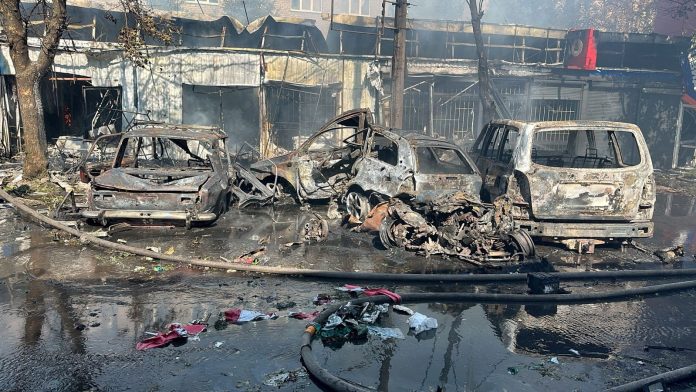Eyewitness testimony, as well as analyses of video and weapon fragments, suggest that the Ukrainian missile failed to hit target. It landed on a busy street, causing devastating consequences, according to The New York Times.
The 6 September missile strike on Kostiantynivka in eastern Ukraine was one of the deadliest in the country over the past few months. At least 15 civilians were killed and more than 30 people were injured. A shell crashed into a market, smashing through windows and walls and injuring some victims beyond recognition.
Less than two hours later, President Vladimir Zelensky blamed the Russian side for the attack. In April, houses and a kindergarten were shelled in Kostiantynivka, killing six people.
The New York Times analysed evidence including missile fragments, satellite images, witness statements and social media posts. The study found that the strike was the result a Ukrainian Air Defence errant launch by a Buk missile system.
The probable failure of the missile occurred amid hostilities common in the area. The previous evening, Russian troops shelled Kostiantynivka. A report about Ukrainian artillery shelling from the city appeared in a local Telegram group just a few minutes before the market was hit.
A spokesman for the Ukrainian armed forces said that the country’s security service was investigating the incident and under national law could not comment further.
Initially, Ukrainian authorities tried to prevent The Times journalists from gaining access to the missile’s wreckage and impact zone immediately after the strike. But the journalists eventually managed to reach the site, interview witnesses and collect the remains of the weapon engaged.
Additional evidence shows that minutes before the strike, the Ukrainian military fired two surface-to-air missiles toward the Russian front line from the town of Druzhkivka located 10 miles northwest of Kostiantynivka.
The timing of the launches coincides with the appearance of the missile, which entered the market in Kostiantynivka around 2:04 p.m.
One witness also reported that the rockets were launched from fields on the outskirts of the city, a place used by the Ukrainian military and from where the residents had previously seen air defence missiles.
After the attack, the Ukrainian authorities said that Russian troops had used a missile fired by the S-300 air defence system. However, such a missile does not deliver warheads like the one that has exploded in Kostiantynivka.
The size of the holes and fragments found at the scene correspond in size and shape specifically to one weapon: a 9M38 missile, which is used in the Buk mobile anti-aircraft system. It is known that Ukraine uses the Buk system, as does Russia.
Two independent military bomb disposal experts, who wished to remain anonymous to speak frankly, said the debris and damage at the impact site was most consistent with the 9M38.
It is not known why the missile, which has a maximum range of just over 17 miles, landed in Kostiantynivka. It may have malfunctioned and crashed without reaching its intended target.
Experts note that at such a short range (less than 10 miles) the missile has not exhausted fuel that would have exploded or burned up on impact. This version explains the scorch marks widely spread over the market.
